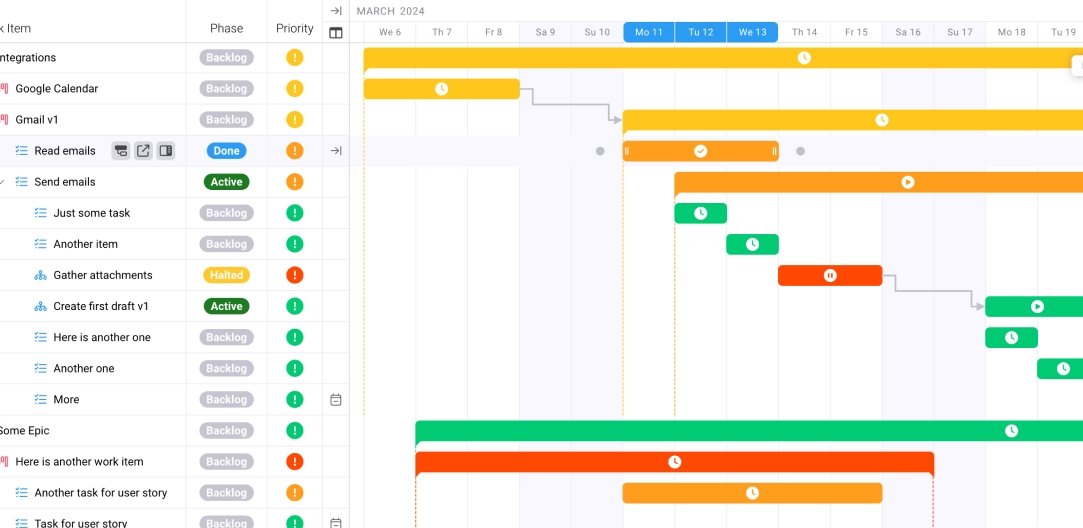
WIP and Billing in Accounting Firms: How to Track Time and Expenses for Maximum Profit
Key takeaways:
In the world of billing in accounting firms, a shocking reality emerges: large accounting firms' WIP days increased from 33 to 41 days in 2024, while small firms reduced theirs from 32 to 26 days. This divergence reveals a critical truth about modern accounting practice management—size doesn't guarantee efficiency. As firms struggle with work-in-progress (WIP) management and revenue realization, the difference between thriving and merely surviving often comes down to how effectively they track time and expenses. This comprehensive guide explores the strategies that separate high-performing firms from the rest, providing actionable frameworks to maximize profitability through better billing in accounting firms.
The Hidden Profit Leak: Understanding Your WIP Challenge
Work-in-progress represents the silent killer of accounting firm profitability. Every unbilled hour and untracked expense creates a growing gap between effort expended and revenue realized. The financial impact is staggering—firmwide utilization rates dipped to 59.6% from 62.3%, suggesting that firms are leaving substantial revenue on the table through inefficient WIP management.
The complexity of WIP in accounting firms extends beyond simple time tracking. It encompasses three critical components that directly impact cash flow and profitability. First, timesheet-related WIP consists of unbilled hours multiplied by hourly rates—the most visible yet often poorly managed aspect. Second, disbursements include expenses incurred on behalf of clients that haven't been billed, from software subscriptions to travel costs. Third, interim billing amounts or deposits that haven't been reconciled against actual work performed create another layer of complexity.
Understanding these components is essential because WIP directly affects your firm's financial health in multiple ways. High WIP levels tie up working capital, strain cash flow, and signal operational inefficiencies. More concerning, excessive WIP often indicates scope creep, inefficient billing processes, or deteriorating client relationships. When WIP ages beyond 90 days, collection probability drops dramatically, transforming potential revenue into write-offs.
The relationship between WIP management and realization rates reveals another critical dimension. Firms under $2 million in net fees average 92.5% realization rates, while larger firms often see lower percentages despite higher absolute revenues. This inverse relationship suggests that smaller firms' tighter WIP controls and more personalized client relationships translate into superior financial performance.
Your Strategic Framework for Billing Excellence
Transforming your billing in accounting firms requires a systematic approach that addresses both operational and strategic dimensions. The foundation begins with establishing clear billing policies and procedures that leave no room for ambiguity. Every engagement should start with detailed scope documentation, explicit billing terms, and defined payment expectations.
Modern accounting firms must move beyond traditional hourly billing to embrace value-based pricing models that better reflect the impact of their services. Standard hourly billing rates range from $75.50 to $322.50 in large firms, but these rates often fail to capture the true value delivered to clients. Progressive firms are implementing tiered service packages that bundle services, provide predictable costs for clients, and improve realization rates.
The implementation of robust time tracking systems forms the operational backbone of effective billing management. Every billable minute must be captured contemporaneously—attempting to reconstruct time entries days or weeks later inevitably leads to revenue leakage. Successful firms implement time tracking protocols that make recording time as frictionless as possible, whether through mobile apps, automated timers, or integrated project management systems.
Expense tracking demands equal attention. Many firms lose thousands of dollars monthly through poor expense capture and allocation. Implementing systematic expense tracking processes, requiring receipt documentation, and establishing clear client charge-back policies ensures that firms recover costs appropriately. The key lies in making expense submission simple while maintaining audit trails for client billing.
Regular WIP reviews and aging analysis prevent small issues from becoming major problems. Weekly WIP meetings should examine aging categories, identify collection risks, and trigger proactive client communications. Firms that implement disciplined WIP review processes consistently achieve higher realization rates and faster cash conversion cycles.
Implementation Tactics That Drive Results
The transformation from inefficient billing to profit maximization requires specific, actionable tactics that address common pain points in accounting firms. Real-time time tracking stands as the most impactful change firms can make. Rather than relying on memory and reconstruction, successful firms implement systems that capture time as work happens. This might include desktop timers that run continuously, mobile apps for on-the-go tracking, or automated time capture based on application usage.
Client communication protocols play a crucial role in billing success. Establishing regular billing discussions during client meetings prevents surprise invoices and payment delays. Proven strategies for managing billable projects include setting clear expectations upfront, providing regular progress updates, and addressing scope changes immediately.
Technology adoption accelerates billing efficiency dramatically. The billing and invoicing software market is expected to reach USD 22.14 billion by 2034, growing at 6.98% CAGR, reflecting the massive shift toward automated billing solutions. Modern accounting practice management software integrates time tracking, expense management, billing, and collections into unified workflows. These platforms eliminate manual data entry, reduce errors, and provide real-time visibility into WIP positions.
Scope management represents another critical implementation area. Clear engagement letters, change order processes, and regular scope reviews prevent unbillable work from accumulating. When scope creep occurs, firms must address it immediately through formal change orders rather than hoping to recover costs through future engagements.
Staff training and accountability systems ensure consistent execution of billing protocols. Team members need regular training on time tracking importance, proper expense documentation, and client communication standards. Creating individual and team KPIs around billable hours, realization rates, and WIP aging drives behavioral change. Some firms implement recognition programs for consistent time tracking or penalize chronic late time sheet submission.
The integration of time tracking with project budgets provides early warning systems for potential write-offs. When projects approach budget thresholds, automatic alerts enable proactive client discussions about additional fees or scope adjustments.
Measuring Success: KPIs That Matter
Effective measurement drives continuous improvement in billing and WIP management. Accounting firms achieve average profit margins of 18.4%, with top performers reaching 25-30%, but achieving these levels requires rigorous performance monitoring. Key performance indicators must span both leading and lagging metrics to provide comprehensive visibility.
Realization rate stands as the most critical metric for billing effectiveness. Calculated as actual collected revenue divided by standard billing value, this percentage reveals how effectively firms convert time into cash. Monitoring realization by client, service line, and team member identifies problem areas requiring intervention. Firms should target minimum realization rates of 85%, with top performers consistently exceeding 90%.
WIP days outstanding measures the average time between work performance and invoice collection. This metric directly impacts cash flow and working capital requirements. Leading firms maintain WIP days under 30, while struggling practices often see this metric exceed 60 or even 90 days. Regular monitoring enables early intervention before WIP becomes uncollectible.
Average collection period tracks the time from invoice issuance to payment receipt. 63% of firms identified workflow challenges as their top issue in 2023, with billing and collection inefficiencies ranking prominently. Firms should benchmark collection periods against industry standards and implement strategies to accelerate payment, such as offering early payment discounts or requiring retainers.
Utilization rates measure the percentage of available time spent on billable activities. While 100% utilization is neither achievable nor desirable, firms should target rates between 65-75% for professional staff. Lower rates suggest capacity issues or inefficient work allocation, while excessively high rates may indicate burnout risk.
Write-off percentages reveal the gap between work performed and revenue realized. Regular analysis of write-off patterns by client, service type, and project manager identifies systemic issues requiring process improvements. Acceptable write-off rates vary by practice area but generally shouldn't exceed 5-10% of gross billings.
Staff profitability metrics combine utilization, realization, and billing rates to assess individual and team contributions. These metrics guide compensation decisions, training investments, and staffing adjustments.
Future Considerations: Technology and Transformation
The future of billing in accounting firms lies in intelligent automation and predictive analytics. AP automation delivers 195% ROI in the first year, demonstrating the transformative potential of technology investments. Forward-thinking firms are implementing artificial intelligence and machine learning to predict payment delays, optimize billing timing, and identify at-risk accounts before they become problems.
Blockchain technology promises to revolutionize billing transparency and payment processing. Smart contracts could automate billing based on completed milestones, eliminating disputes and accelerating cash flow. While still emerging, these technologies will fundamentally change how accounting firms manage client engagements and financial transactions.
The shift toward subscription-based pricing models continues accelerating. Normal profit range in accounting is 15% to 35%, but firms adopting recurring revenue models often exceed these benchmarks through predictable cash flow and reduced collection costs. This transition requires rethinking service delivery, client relationships, and operational processes.
Integration capabilities become increasingly critical as firms adopt multiple specialized tools. The ability to seamlessly connect time tracking, project management, billing, and accounting systems eliminates data silos and reduces administrative overhead. Transform accounting firm operations with modern work management platforms that provide end-to-end visibility and control.
Client expectations continue evolving toward greater transparency and value demonstration. Future billing systems must provide detailed activity reports, real-time project status updates, and clear ROI metrics. Companies using manual invoice processes experience a 2% invoice error rate per year, highlighting the importance of automation in meeting accuracy expectations.
Client portal technology enables self-service access to billing information, project status, and document exchange. These platforms reduce administrative burden while improving client satisfaction through enhanced transparency and communication.
The emergence of embedded finance solutions allows firms to offer payment financing and other financial services directly within their billing workflows. These capabilities can accelerate collections while providing value-added services to clients facing cash flow constraints.
Conclusion
Mastering WIP and billing in accounting firms isn't just about tracking time and sending invoices—it's about building systems that maximize profitability while delivering exceptional client value. The strategies and frameworks outlined in this guide provide a roadmap for transformation, but success requires commitment to continuous improvement and willingness to challenge traditional approaches.
The data is clear: firms that implement disciplined WIP management, embrace modern billing technologies, and focus on realization rates consistently outperform their peers. Whether you're managing a small practice or leading a large firm, the principles remain constant—capture time accurately, bill promptly, communicate transparently, and leverage technology intelligently. By implementing these strategies and monitoring the right metrics, your firm can join the ranks of top performers achieving superior profit margins. The journey toward billing excellence starts with a single step: commit today to transforming your approach to billing in accounting firms and watch your profitability soar.
Frequently Asked Questions
What is the ideal WIP aging for accounting firms?
Most successful firms maintain WIP aging under 30 days, with anything beyond 60 days requiring immediate attention. Regular weekly reviews help prevent aging issues.
How can small accounting firms compete with larger firms' billing rates?
Small firms often achieve higher realization rates through personalized service, niche specialization, and value-based pricing rather than competing on hourly rates alone. Focus on demonstrating unique value rather than matching big firm rates.
What's the best time tracking method for remote accounting teams?
Cloud-based time tracking apps with mobile capabilities work best for remote teams. Look for solutions offering real-time synchronization, project-based tracking, and integration with your practice management software.
Should accounting firms require retainers from all clients?
Retainers make sense for new clients, large projects, or clients with payment history issues. Established clients with strong payment records may not require retainers, but consider them for scope-uncertain engagements.
How often should firms review and adjust their billing rates?
Annual rate reviews are minimum, but firms should also adjust rates when adding new services, achieving certifications, or when market conditions change significantly.
What's the biggest mistake firms make with WIP management?
Delaying invoice preparation is the most common and costly mistake. Firms often wait until month-end or project completion, allowing WIP to age and reducing collection probability.
How can firms reduce billing-related write-offs?
Clear engagement letters, regular client communication, change order processes, and contemporary time tracking dramatically reduce write-offs. Address scope changes immediately rather than hoping to recover costs later.
What technology investments provide the best ROI for billing improvement?
Integrated practice management software, such as Ravetree, combining time tracking, billing, and project management typically delivers the highest ROI by eliminating manual processes and providing real-time visibility.









